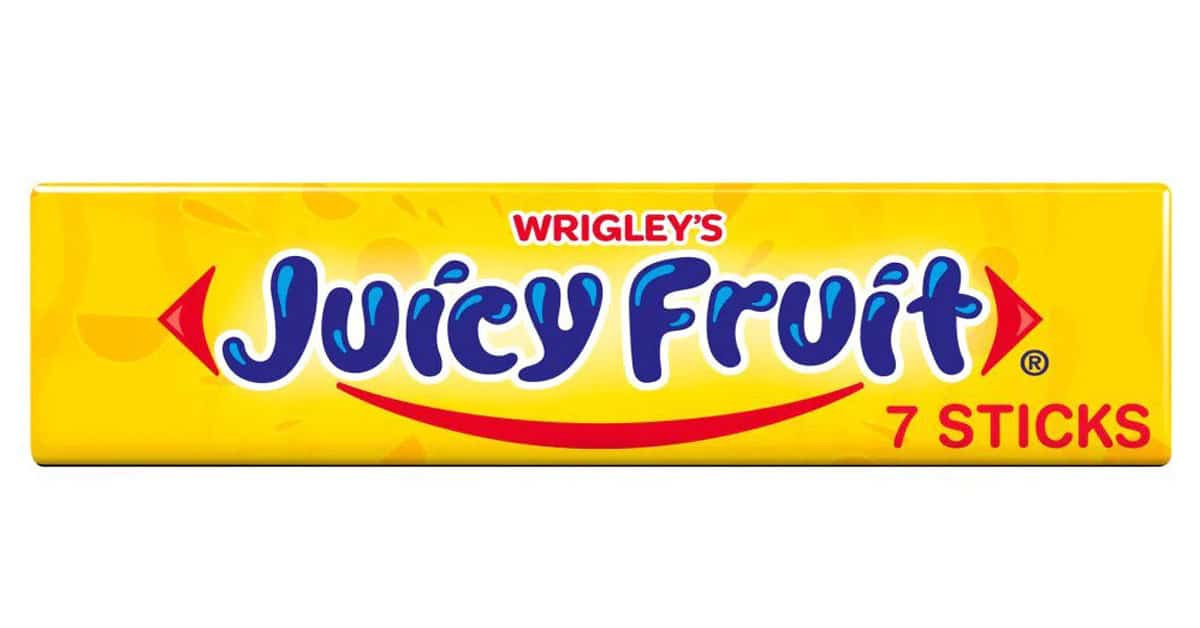Juicy Fruit Gum – Delicious Chewing Gum With Mysterious Flavor
Juicy Fruit Gum, the iconic fruit gum that has captured the hearts of generations, has remained a beloved favorite among Americans for over a century. As the number one fruit gum brand in the United States, the popularity of Juicy Fruit endures to this day, thanks to its irresistible flavor and unique texture.
The chewing gum brand Juicy Fruit is produced by the Wrigley Company, a U.S. business that has been a division of privately held Mars, Incorporated, since 2008. Today, 99% of Americans are familiar with the brand name, which was initially introduced in 1893.
Please leave a review or any memories of this snack in the comments at the bottom of this page. Thank you!
In this article, you will discover the fascinating history, noteworthy milestones, and interesting facts about delicious and mouthwatering Juicy Fruit Gum.
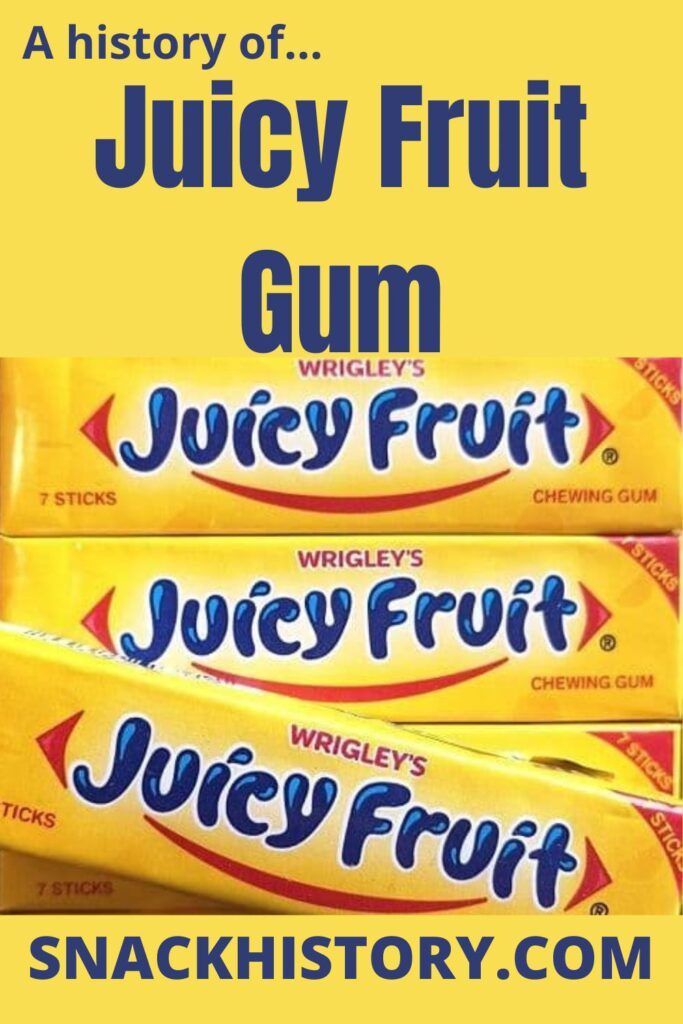
Overview
When William Wrigley Jr. launched his new company in Chicago, he initially sold his father’s scouring soap and offered complimentary baking powder to encourage people to buy it. Wrigley Jr. moved to making and selling baking powder since, regrettably, it was far more sought-after than the scouring soap.
In 1892, he decided to offer a complimentary present to his baking powder customers and attached a few sticks of chewing gum to the package.
Since chewing gum was far more in demand than baking powder, Wrigley Jr. once again shifted his focus to producing and selling chewing gum. Lotta Gum and Vasser were his first two brands manufactured by the Wrigley Company. Wrigley used as much promotion as he could to spread the word about his gum to customers in an extremely competitive chewing gum business.
Juicy Fruit gum was a new flavor that Wrigley Jr. released in 1893, and it helped the Wrigley Company grow into the most well-known and prosperous chewing gum manufacturer in the world. As synthetic rubber grew more affordable to produce, Wrigley’s chewing gum’s composition was modified in the 1960s.
Wrigley increased its promotion for the Spearmint brand in 1907, paying a staggering $284,000 at the time. In 1910, Wrigley’s Spearmint was the best-selling gum in the US, and the firm grew to become the biggest gum producer in the world.
History of Wrigley Company
As already mentioned above, the originator of the business, William Wrigley, Jr., was a soap salesman and something of a young prodigy of consumerism. He began making a reputation for himself at the age of 13 by selling soap for his father around New England. Eventually, he ended up in Chicago, where he pitched rubber stamps, newspapers, and soap.
The Wm. Wrigley Jr. Company, sometimes referred to as the Wrigley Company, is a global American chewing gum (Wrigley’s gum) manufacturer with headquarters in Goose Island, Chicago, Illinois.
In 2016, Mars announced that Wrigley and its chocolate division would combine to establish a new business called Mars Wrigley Confectionery. The new business kept its headquarters in Chicago but relocated its American operations to Hackettstown and Newark.
With his newfound wealth, Wrigley bought Chicago Cubs shares in 1916, and five years later he owned a controlling stake in the team. Around that time, Wrigley also acquired the Los Angeles Baseball Club. Additionally, he bought shares in the Santa Catalina Island Company.
For US$1.5 billion, Wrigley acquired Life Savers and Altoids from Kraft Foods in 2005. Currently, the company operates in more than 50 countries, sells its goods in more than 180 nations and districts, and has 21 production facilities spread across 14 nations. The locations include the US, Mexico, Spain, the UK, France, the Czech Republic, Colombia, Poland, Russia, China, India, Japan, Kenya, Australia, and New Zealand.
Packaging Design
When the product line first came out, it had a plain wrapper with the words “Juicy Fruit” inscribed across it in tiny, red block letters. The words “Wrigley’s Juicy Fruit Chewing Gum” were in the center of a stylized Maltese cross symbol on a black background. Wrigley made this modification in 1914. Juicy Fruit gum was briefly taken off the consumer market during World War II due to a lack of ingredients and a desire to use the gum in C-rations.
After World War II, the packaging’s striped design was replaced with one with a bright yellow backdrop and the words “Juicy Fruit” bracketed between two stylized chevrons. The “Wrigley arrow” motif, which has been used for Wrigley’s Spearmint since 1893, was intended to be evoked by doing this.
The brand name appeared beneath an extended smile, with modifications since 2002, on a brilliant yellow backdrop that persisted until the twenty-first century. Wrigley’s substituted aspartame and Ace K for some of the sugar in Juicy Fruit in the United States in 2003.
In 1902, Juicy Fruit gum packets came with redeemable gift certificates, but the prizes were incredibly arbitrary. Some of them featured an inkstand, a 32-piece tea set, a mirror, an umbrella, and more.
Logo
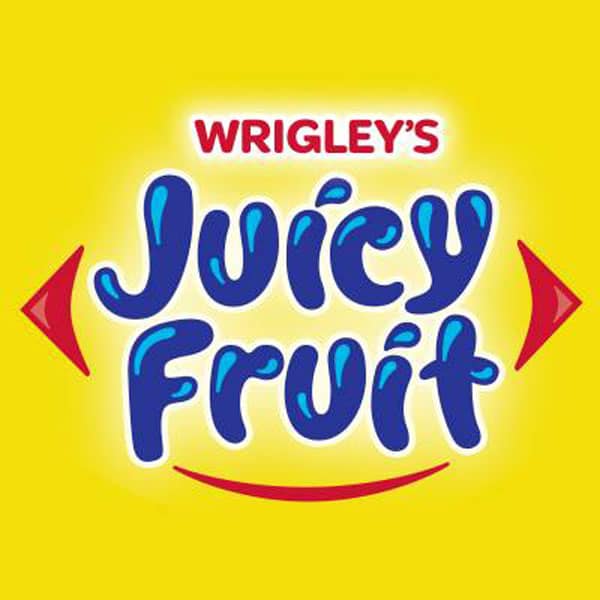
Influence of Pop Culture on Juicy Fruit Gum
Wrigley’s began offering Juicy Fruit without sugar in 2009. Jimmy Buffett, an American singer-songwriter of popular music, wrote and sang the song “Grapefruit-Juicy Fruit.” It was his third single from the album A White Sport Coat and a Pink Crustacean, which was released in 1973. The song’s top position on the Billboard Easy Listening chart in September 1973 was number 23.
Separately, Juicy Fruit TV ads from the 1980s had the tagline, “The flavor, the taste, the taste is going to move ya!
Surveys & Customer Research
Juicy Fruit Gum, the Wm. Wrigley Jr. Company’s oldest brand, did not have a big adolescent market following back in the 1990s. The business came under pressure from rivals in 1997. Market share and sales both declined. Wrigley sought information from the source.
Teens who chewed five or more sticks of Juicy Fruit gum per week were approached by marketing researchers, who gave them the homework assignment: look for images that make you think of Juicy Fruit gum and compose a brief essay about it. Wrigley discovered from the children’s stories that they chew Juicy Fruit gum because it is delicious. They claimed it gave them energy and renewed them.
The advertising firm for Wrigley, BBDO, corroborated the claims made by the teenagers. In a survey study, BBDO asked more than 400 frequent chewers of gum to rank various brands according to the characteristics that best characterized them. Respondents chose words like “is made with natural sweetness” and “has the proper amount of sweetness” for Juicy Fruit.
Ingredients
Sugar is the main ingredient of Juicy Fruit gum, which has a synthetic gum foundation. Other components include aspartame and acesulfame K as artificial sweeteners. Corn syrup and dextrose are used as bulking agents and natural sweeteners. The Juicy Fruit gum also contains natural and artificial flavorings, glycerol and lecithin as softening agents, Yellow Lake 5 as coloring, and BHT as a preservative.
Sugar, Gum Base, Glucose Syrup, Flavourings, Humectant (Glycerol), Emulsifier (Soybean Lecithin), Sweeteners (Acesulfame K, Sucralose), and Antioxidants are the components used in the UK version of the candy.
Nutrition
| Serving Size: | 1 stick (2.7g) | % Daily Value* |
| Amount Per Serving | ||
| Calories | 10 | |
| Calories from Fat | 0 | |
| Total Fat | 0g | 0% |
| Total Carbohydrates | 2g | 1% |
| Sugars | 2g | |
| Protein | 0g |
- Percent Daily Values are based on a 2000-calorie diet.
Secret Flavor
If you have yet to experience the original Juicy Fruit flavor, you may be curious as to what it tastes like. Despite its name, the gum’s packaging offers no indication of the actual fruits that make up its flavor. In fact, a 1946 gum wrapper simply referred to it as “a remarkable artificial flavor.” However, one thing is certain – the taste of Juicy Fruit is unique and unmistakable. With a blend of fruit notes that create a medley of deliciousness, the flavor of Juicy Fruit has captured the hearts of candy lovers for over a century.
It turns out that Wrigley has never disclosed the flavor of Juicy Fruit. An interested fan wrote to Wrigley in 2002 to inquire about the notes in Juicy Fruit gum. Sources claim that they got a letter that said that the brand considered the recipe for our Juicy Fruit flavor to be a trade secret for competitive reasons, therefore they could not be more precise. But they could tell that the fruit flavors in Juicy Fruit are mostly composed of notes of lemon, orange, pineapple, and banana.
Some Juicy Fruit gum consumers have even gone so far as to wonder if the flavor is derived from jackfruit, a tropical Southeast Asian fruit with characteristics of sweetness, tang, and flesh. Chemists who have researched the gum claim that Juicy Fruit may smell like jackfruit because it contains the chemical isoamyl acetate.
According to Chemoxy, isoamyl acetate, often known as banana oil, is a typical constituent in traditional bubblegum as well as fragrances, nail paint, and even beer. But much like with the traditional pink bubblegum flavor, we might never be able to pinpoint this tasty treat’s precise flavor profile.
Interesting Facts
- Juicy Fruit gum was the very first item to ever be scanned with a bar code and it happened in 1974.
- For Halloween in 1988, George W. Bush’s daughter Jenna Bush dressed like a Juicy Fruit gum pack.
- Actor Aaron Paul really appeared in a Juicy Fruit advertisement before his time on Breaking Bad.
- In “The Great Fruit Gum War” of 1893, Juicy fruit gum was developed to compete with other fruity gum products. Adams California Fruits and Primely’s California Fruit were two further rival brands.
Pictures
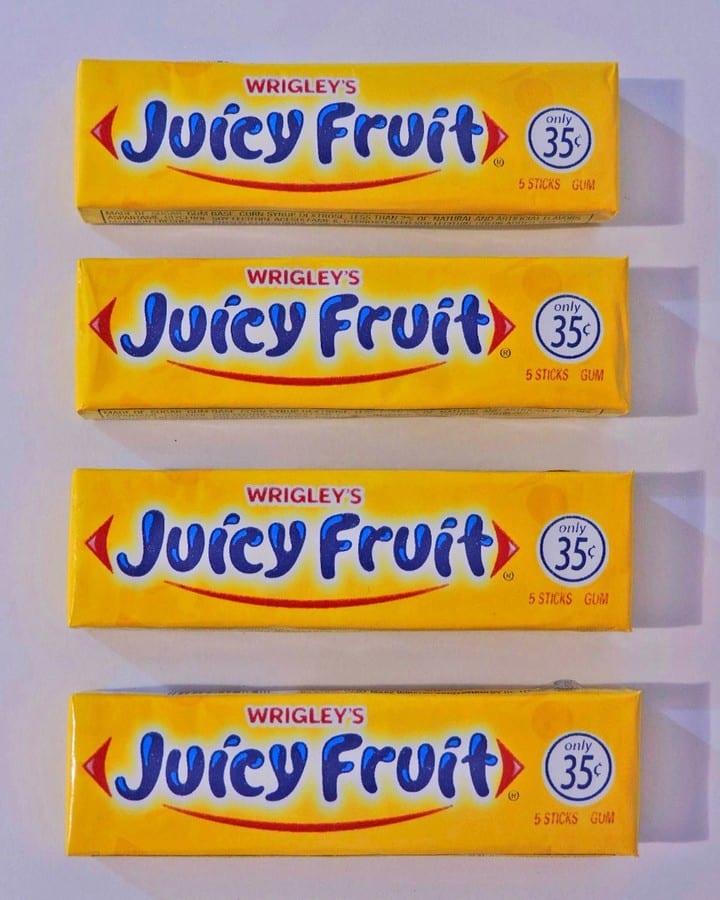
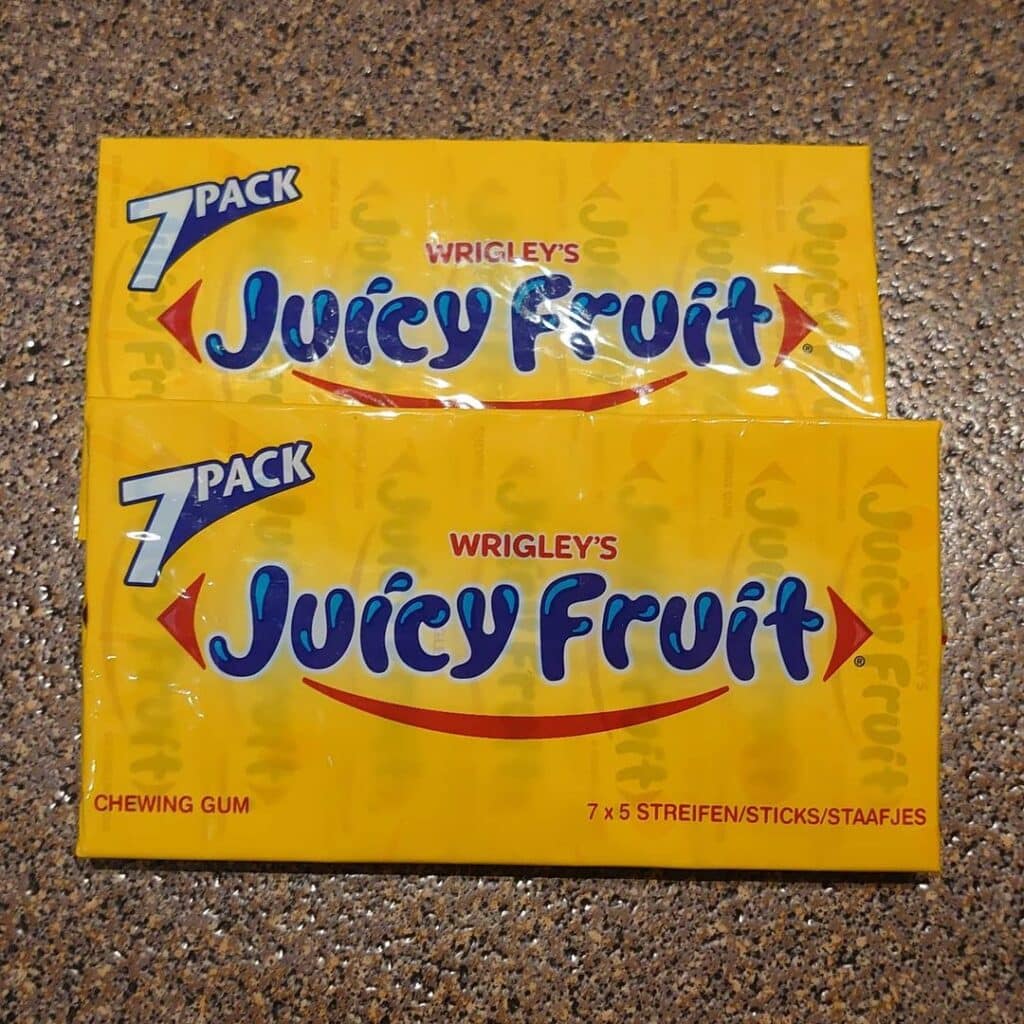
Commercials
Bottom Line
Juicy Fruit gum lives up to its name with its vibrant yellow hue and a burst of delectable fruit flavor, making it a well-known and beloved chewing gum brand. According to the National Museum of American History, Juicy Fruit was first introduced by the Chicago-based confectionery company Wrigley in 1893, and it has since become a fan favorite among customers for many decades. With its distinctive taste and eye-catching packaging, Juicy Fruit has firmly established itself as a pop culture icon and a staple in the world of candy.
FAQ
What flavor is Juicy Fruit Gum?
Which fruit serves as the model for its flavor is kept vague in advertising, though in 2003, advertising agency BBDO characterized it as a combination of banana and pineapple, and some people say it resembles jackfruit.

Nato is a content writer and researcher with a background in psychology. She’s passionate about writing about the candy industry and exploring the cultural significance of sweets and treats. She believes that the stories behind our favorite snacks can reveal a great deal about our values.
Please leave a review or any memories of this snack in the comments below. Thank you!
Click here for a full A-Z list of Snacks and Candy
